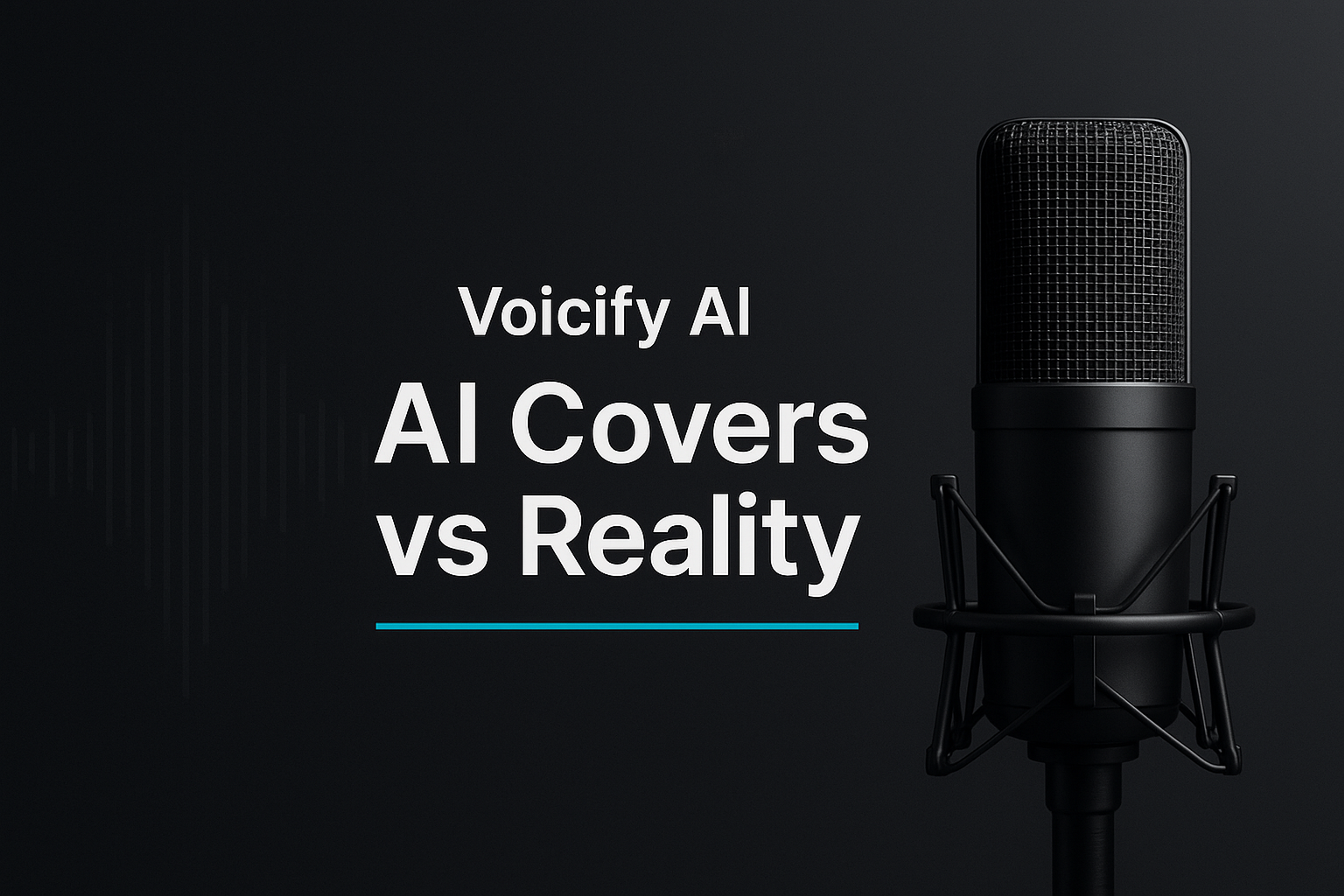Most people hear about Voicify AI the same way: a friend sends an AI Drake cover that sounds illegal in three different jurisdictions and a little too good for a weekend hack.
That’s the pitch in one line: Voicify AI rode the AI covers wave - community models, cloned artist voices, quick-upload songs, big social reach. It blurred the line between fan creativity and copyright roulette.
If you are a creator, editor, or brand operator, you do not have time for vibes. You care about three things:
- Will this help me ship better content, faster
- Is it legal and safe to use in public
- Where does a tool like Listnr fit into this mess
This guide is the straight-cut version of Voicify AI - how it worked, what it enabled, why it ran into trouble, what replaced it, and how serious teams should think about AI music and voice tools now.
TL;DR: Should You Use Voicify AI Or Anything Like It?
Good fit if your goal is:
- Non-commercial AI covers, fan projects, experiments
- Playing with community voice models and aesthetics
- Understanding what is possible with AI voice in music
Bad fit if:
- You run a YouTube brand, label, agency, or SaaS where IP, advertisers, or clients are involved
- You need clean licensing, predictable policies, and zero “wait is this infringing?” anxiety
For real businesses:
- Treat Voicify-style tools as case studies, not core stack
- Use Listnr or similarly compliant tools for production voiceovers, explainers, ads, dubs, and product content
What Was Voicify AI?
Voicify AI (not to be confused with Voicify, the enterprise conversational AI platform) started as an AI music covers engine:
- Upload or select a song
- Pick from a catalog of community-trained artist-style voices
- Generate AI covers that sound like major singers and rappers
It was:
- Fast
- Viral
- Technically impressive
- Built on legally fragile ground: large-scale cloning of artist likeness and catalog-adjacent content without clear licenses
Fun for users. A red flag for rights holders.
The Voicify AI → Jammable Saga (Why It Matters)
Voicify AI’s trajectory is a case study every creator and builder should internalize:
- Music industry bodies and rights holders started paying attention to AI vocal cloning platforms
- Voicify AI, facing mounting pressure and risk, effectively disappeared as a public brand and resurfaced as Jammable with a different positioning
Key lesson: if your core value prop is “we sound like famous people who never consented,” you do not have a stable foundation for anyone whose income or brand depends on compliance.
If you are running a serious content business, your stack cannot be one DMCA away from collapse.
How Voicify-Style Platforms Work (High Level)
Tools like Voicify AI typically offered:
1. AI covers generation
- Choose an AI voice model (often styled after real artists)
- Feed vocals or a track stem
- Model transforms the performance into the target voice
Good for:
- Fan edits
- Creator culture
- Proof-of-concept AI music workflows
Not good for:
- Anything needing long-term legal clarity
2. Community voice models
- Users upload and share models
- Catalog explodes with more artists, more styles, more niche sounds
Upside:
- Variety and speed
Downside:
- Inconsistent quality
- Zero guarantee on rights or provenance
3. Freemium tiers
Most followed a simple pattern:
- Free: limited usage, watermarks or queues
- Paid: more conversions, more models, faster processing
When legal risk starts to outweigh revenue, that model stops working.
Where Voicify-Style Tools Actually Shine
If you strip away the legal headaches and look only at product value:
- Incredible sandbox to understand how far AI vocals can go
- Great for:
- Non-monetized fan projects
- Private experimentation
- Learning how neural voice models behave
- Cultural relevance: they proved AI covers are a mainstream format, not a toy
If you are a builder, Voicify’s early traction is the demand signal. Its rebrand and retreat are the warning label.
The Problems (If You Care About Longevity)
1. Legal and licensing risk
Using AI models that mimic real artists without consent is not a long-term grey zone. If your channel, client, or campaign leans on that, you are inviting takedowns and potential claims.
2. Commercial uncertainty
Even when platforms say “non-commercial only,” users ignore it:
- Monetized videos with unlicensed artist-style vocals
- Brands and agencies unknowingly using risky voices in campaigns
No CMO wants to defend an AI clone in a board meeting.
3. Reliability and control
Community-first platforms:
- Vary wildly in model quality
- Offer limited control over pronunciation, timing, emotion, or multilingual delivery
- Do not prioritize batch workflows, collaboration, auditability, or SLAs
For scaled operations, all of this is friction.
Voicify AI vs Listnr: Different Tools, Different Jobs
Ignore hype and run the “job to be done” test.
When a Voicify-style tool makes sense
- You are exploring AI covers as a creative medium
- You are experimenting privately or for clearly non-commercial use
- You want to understand what is technically possible, not deploy production assets
- You respect non-commercial and platform constraints
When Listnr is the right call
You are:
- Running monetized YouTube channels (faceless or branded)
- Producing paid ads and UGC ads for clients
- Creating training content, onboarding flows, support libraries, or product explainers
- Publishing at volume for brands that care about:
- clear licenses
- predictable output
- multi-language coverage
- long-term safety
Listnr gives you:
- A curated library of high quality voices across many languages and accents
- Control over tone, speed, pauses, emphasis, and emotions
- Scalable workflows for agencies and teams - projects, collaboration, batch exports
- Straightforward commercial usage so you are not decoding legal PDFs at midnight
Voicify-style tools proved there is appetite for AI voices. Listnr is built so you can capture that upside without detonating your risk profile.
How To Think About AI Covers In 2025 (Without Getting Burned)
A simple framework:
- Is this commercial or brand-facing content?
- If yes: avoid unlicensed artist-style cloning. Use licensed, neutral, or original voices.
- Can I defend this voice choice in one sentence to an artist, label, or client?
- If no: do not ship it.
- If this platform vanished tomorrow, would my pipeline survive?
- If no: it is a toy, not infrastructure.
FAQs About Voicify AI
Did Voicify AI shut down?
The original Voicify AI brand effectively disappeared and its technology and positioning shifted under a new banner. It is not the same open AI-covers playground people remember.
Is Voicify AI safe for commercial use?
As a rule of thumb: no, not for anyone risk-averse. Any platform built around unlicensed celebrity or artist-style voices is legally sensitive. Treat it as non-commercial unless explicit, verifiable rights are provided.
Is Voicify AI the same as the Voicify enterprise platform?
No. Same word, different companies, different products.
What should I use for production-grade voiceovers?
Use platforms that:
- Offer original or properly licensed voices
- Are transparent about commercial rights
- Deliver consistent quality at scale
That is the gap Listnr is designed to fill: high quality, compliant, production-ready voiceovers for creators, agencies, and companies who plan to be around in 5-10 years.

About Ananay Batra
Founder and CEO @ Listnr Inc
Ananay is the Founder & CEO of Listnr AI, he started Listnr with $100 in the bank back in 2020 and scaled it to 3mn+ users across 200 countries and $1.2m in revenue.
https://ananay.ai/